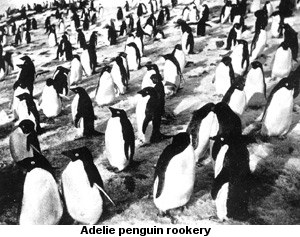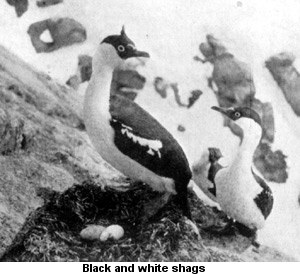
| Glasgow Digital Library | Voyage of the Scotia | BRUCE | PEOPLE | SHIP | ANTARCTIC | INDEX |
|---|

In the rookery the penguins paired and made their nest of small stones. In October millions of penguins had walked past the ship and it was estimated there were 5,000,000 penguins on Laurie Island. The eggs were laid at the end of October. Skuas hovered around to steal the eggs, as did the Scotia crew. Over 2,000 eggs were collected by the shore parties, and buried in a pit for next year's winter party. The average consumption of eggs over the next two weeks was 15 per head per day. There were a few emperor penguins and macaroni penguins.
Black-backed gulls nested at Point Davis and Arctic terns were found on the island. Cape pigeons (a small petrel) nested in the cliffs. There were also large rookeries of giant petrels (up to 200 in each). On the Rudmose Rocks black-and-white blue-eyed shags nested on beds of lichens, moss and feathers.
Many seals were killed for their meat, their skeletons and their skins. When Scotia returned home, most Scottish museums were given a stuffed Weddell seal. Attempts had been made to cut the ice around Scotia in September using special ice saws and dynamite. September had been colder than August, and although Scotia was afloat once more she was still surrounded by ice. It was 22 November 1903 before a north wind cleared the ice out of the bay and on 27 November she set sail for the Falklands and Buenos Aires.

| Glasgow Digital Library | Voyage of the Scotia | BRUCE | PEOPLE | SHIP | ANTARCTIC | INDEX |
|---|